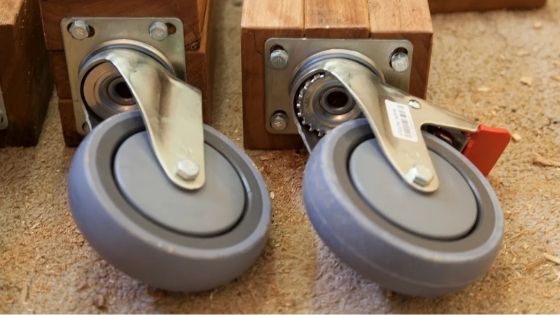A castor wheel is a small, free-rolling and undriven wheel that is usually connected to a bigger object; thus, allowing for easy movement on the floor and other hard surfaces. There is a wide variety of castor wheels that are used in office and commercial applications. Choose the right castors for your specific needs to reduce long-term costs and maximum productivity.
You can find a range of heavy-duty castors in the manufacturing, industrial, and service industries, including in:
- Platform trucks
- Lifting and moving apparatus
- Warehousing applications
- Hospital beds and stretchers
- Workbenches
- Car production plants
- Moving and lifting apparatus
- Produce handling equipment and shopping trolleys
- Luggage racks
- Aircraft assembly
How to Attach Castor Wheels?
The design, model, and make of the wheel determine the proper way to attach it. Read the instructions from the manufacturer for more guidance. The flat plate is the most popular castor wheel assembly. They affix through bolts or screws, passing the plate holes into the vehicle. When mounting the castors, keep these things in mind:
- The vehicle surface should be rigid and dense, so it is able to support its weight across the top plates of the wheels.
- Make your hole markings by placing the top plate in a specific spot and marking the entries of the bolts and screws on the body of the machinery.
- Regardless of the number of castors you need to attach, it is crucial to obtain optimum stability and balance. So, distribute them evenly across the base of the equipment.
- When you need to connect the bolts or screws directly into a piece of machinery or furniture, it is necessary to drill holes through it first to secure the attachment and avoid damage.
- Make sure to test the castor wheels for their overall functionality and the maneuverability of the machine before you use them into service.
If the equipment you are attaching the castors has a straight movement, for example, heavy machinery for cleaning, you may need to use fixed castors for this. If you want greater maneuverability, get swivel castors for this. The main reason for installing a castor wheel is to be able to move an object, but you should also determine how much flexibility you need in that motion. For this, find out if you need swivel locks for your castors.
Consider the Wheel Diameter
The rule of thumb is you need a larger castor diameter if the load weight is greater. This is because bigger castors roll more easily and offer an even weight distribution. Other factors that impact the wheel diameter you choose are the breaking requirements, flooring condition, the noise level of the castor, the style, and the overall environment your wheels will traverse.
Take into Account the Flooring
It is essential to consider the flooring condition when choosing the right wheels for your equipment. They should be able to travel over tracks, cracks, and other floor obstructions. You also want to reduce the damage the hard wheels could inflict on the floors. Generally, soft wheels are suitable for rough or hard floor surfaces, while hard castors are better on smooth or soft flooring.
Portability and productivity are necessary for various settings, and castor wheels can offer movement for a range of applications. The right wheels you choose can make your job, such as material handling and transport, much safer and easier.

















Comments